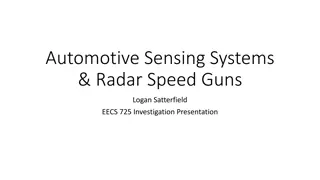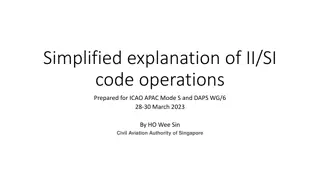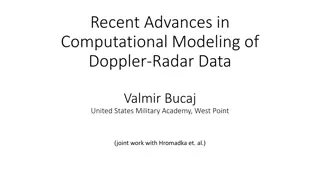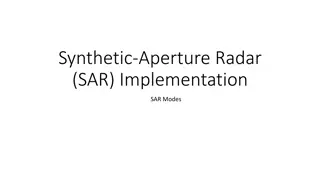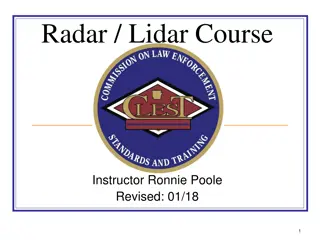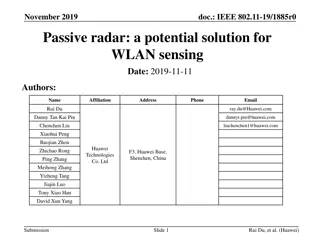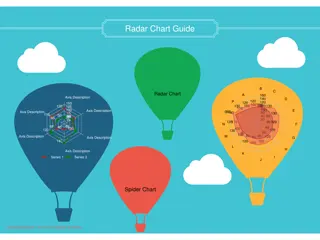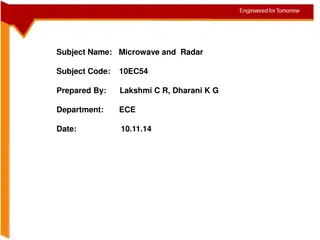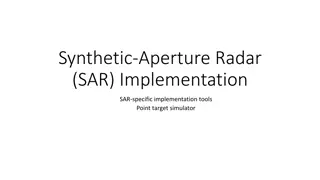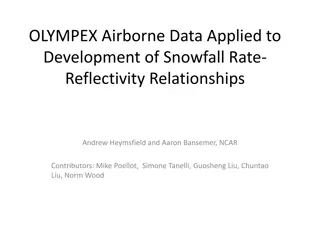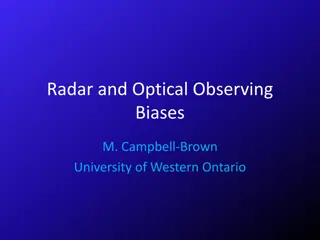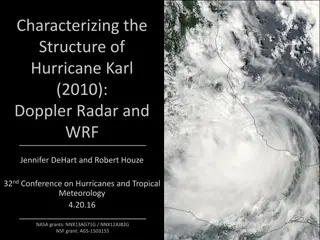Understanding Radar Fundamentals
Radar is an object detection system that uses electromagnetic waves for identifying the range, altitude, direction, or speed of moving and fixed objects. It operates on principles of reflection and time measurement, enabling distance and direction determination, elevation angles, and range resolution. Various types of radars like CW, FMCW, and PRF serve different purposes in applications such as aircraft, ships, and weather formations.
Download Presentation

Please find below an Image/Link to download the presentation.
The content on the website is provided AS IS for your information and personal use only. It may not be sold, licensed, or shared on other websites without obtaining consent from the author. Download presentation by click this link. If you encounter any issues during the download, it is possible that the publisher has removed the file from their server.
E N D
Presentation Transcript
Radar Fundamentals PRESENTED BY: REHAM MAHMOUD ABD EL- FATT AH ALI
What is Radar? It is an object detection system that uses electromagnetic waves to identify the range ,altitude ,direction or speed of both moving and fixed objects such as aircrafts ,ships ,motor vehicles ,weather formations and terrain. RADAR is an acronym for RAdio Detection And Ranging
Types of Radar? Radars CW = continuous wave FMCW = frequency modulated continuous wave PRF = pulse repetition frequency Pulsed CW Noncoherent Coherent FMCW Low PRF Medium PRF High PRF
What is Principle of Operation? 1- Reflection of electromagnetic waves 2-Measurement of running time of transmitted pulses
What is Principle of Measurement? Distance Determination. Direction Determination. Elevation Angle. Range Resolution.
1-Distance Determination: Slant range: is the line of sight distance between the radar and the object illuminated. R = c0 t/2 where: c0 = speed of light = 3 108 m/s t = measured running time [s] R = slant range antenna - aim [m] The distances are expressed in kilometers or nautical miles (1 NM =1.852 km)
2-Direction Determination The angular determination of the target is determined by the directivity of the antenna. Directivity, directive gain: is the ability of the antenna to concentrate the transmitted energy in a particular direction.
3-Elevation Angle The elevation angle :is the angle between the horizontal plane and the line of sight, measured in the vertical plane. The Greek letter Epsilon ( ) describes the elevation angle
4-Range Resolution: Range resolution : is the ability of a radar system to distinguish between two or more targets on the same bearing but at different ranges. The degree of range resolution depends on the width of the transmitted pulse, the types and sizes of targets, and the efficiency of the receiver and indicator. Pulse width is the primary factor in range resolution. R = R 2 R 1 = c / 2 . where: c0 = speed of light = 3 108 m/s = pulse width time
What are Radar Timing Parameters? Pulse Repetition Frequency. Duty Cycle. Dwell Time.
What is Pulse Repetition Frequency? The Pulse Repetition Frequency (PRF) of the radar system is the number of pulses that are transmitted per second.
What is Duty Cycle? Duty cycle is the proportion of time during which component, device, or system is operated.
What is Dwell Time? The time that an antenna beam spends on a target is called dwell time TD. The dwell time of a 2D search radar depends predominantly on: 1) the antennas horizontally beam width AZ and 2) the turn speed n of the antenna (rotations per minute). The dwell time can be calculated using the following equation: TD= ( AZ 60)/(360 n) ; in [seconds] The number of pulses that will hit the target in this time is nB = TD.f p
What is Maximum Detection Range?
What are types of Interference? Noise. Clutter. Jamming.
What is Noise? Signal noise is an internal source of random variations in the signal, which is generated by all electronic components. Noise is also generated by external sources, most importantly the natural thermal radiation of the background scene surrounding the target of interest.
What is Clutter? Radio frequency (RF) echoes returned from targets which are uninteresting to the radar operators.
What are types of Clutter? The basic types of clutter can be summarized as follows: 1) Surface Clutter Ground or sea returns are typical surface clutter. 2) Volume Clutter Weather or chaff are typical volume clutter. 3) Point Clutter Birds, windmills and individual tall buildings are typical point clutter and are not extended in nature.
What is Jamming? Radio frequency signals originating from sources outside the radar, transmitting in the radar's frequency and thereby masking targets of interest.









